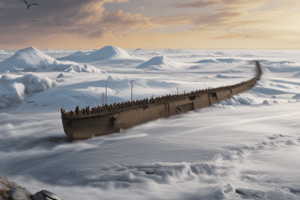Podcast
Questions and Answers
What is Beringia?
What is Beringia?
The land between Siberia and Alaska that was exposed during the Ice Age.
Who were the Incas?
Who were the Incas?
South American Indian peoples located in Peru before the Spanish conquest.
Who were the Aztecs?
Who were the Aztecs?
American Indian peoples that controlled present-day Mexico before the Spanish conquest.
What did the Anasazi build?
What did the Anasazi build?
What are Pueblos?
What are Pueblos?
Where is Cahokia located?
Where is Cahokia located?
What are Algonquins?
What are Algonquins?
What is the Five Nations of Iroquois?
What is the Five Nations of Iroquois?
Who were the Conquistadores?
Who were the Conquistadores?
What is the Columbian Exchange?
What is the Columbian Exchange?
Flashcards are hidden until you start studying
Study Notes
Beringia
- Land bridge that connected Siberia and Alaska during the Ice Age, facilitating migration to the New World.
- Defined as a region around the Bering Strait, it acted as a migration route for humans, plants, and animals.
- Composed of a steppe region with areas that may have been tundra, supporting diverse plant and animal life.
Incas
- Pre-Columbian South American civilization, prominent in Peru prior to Spanish conquest.
- Established the largest empire in pre-Columbian America around the 13th century.
- Suffered significant population decline due to European diseases, lacking immunity for introduced pathogens.
- Francisco Pizarro conquered the Incas in 1532, aiming for their wealth.
Aztecs
- American Indian civilization controlling present-day Mexico before Spanish conquest.
- Practiced human sacrifices, particularly during significant events like the crowning of a chieftain, often involving thousands of victims.
- Their capital was Tenochtitlán, a major city showcasing their power and culture.
- Hernan Cortes sought wealth in Aztec lands, leading to conflicts including Noche Triste, resulting in Aztec defeat through disease and warfare.
Anasazi
- Ancient Native American people residing in the southwestern United States, particularly Chaco Canyon.
- Founded extensive pueblo structures, with intricate connection of over 600 rooms.
- Mysteriously declined around 1300 CE; their agricultural practices, especially maize cultivation, supported large settlements.
Pueblos
- Indigenous settlement types in the Southwestern U.S., characterized by adobe houses.
- Exhibited a simpler social structure compared to other civilizations, with economies based on trade and agriculture.
- Indigenous peoples faced mistreatment during Spanish explorations, particularly by Francisco Coronado in his search for gold cities.
Cahokia
- Major Mississippian settlement located near present-day East St. Louis.
- Home to approximately 20,000 people, featuring a significant central square dominated by Monks Mound, comparable in size to Egyptian pyramids.
Algonquins
- Refers to a family of Native American tribes speaking related languages in North America.
- Historically inhabited areas across the Great Lakes, Great Plains, and the Atlantic seaboard.
Five Nations of Iroquois (Iroquois Confederacy)
- Alliance of five Native American tribes, known as the "people of the longhouse," initially comprising the Mohawk, Oneida, Onondaga, Cayuga, and Seneca.
- The confederacy expanded to include the Tuscarora in 1722, thus becoming the Six Nations.
Conquistadores
- Spanish conquerors who played a crucial role in the exploration and conquest of the Americas.
- Motivated by the pursuit of "god, glory, and gold," they spread throughout the Caribbean and the continent.
- Leveraged advantages of diseases, horses, and gunpowder in conflicts with indigenous civilizations.
- Key figures like Hernan Cortes and Francisco Pizarro led campaigns against the Aztec and Incan empires, respectively.
Columbian Exchange
- A significant transfer of animals, culture, plants, diseases, and ideas between Afro-Eurasia and the Americas during the 14th to 16th centuries.
- Initiated by Christopher Columbus's voyages, which introduced Old World crops and animals to the New World.
- The exchange included commodities such as gold, silver, and crops from the New World to the Old World, alongside adverse elements like smallpox and other diseases.
- Africa contributed to the exchange by supplying slave labor for New World plantations and economies.
Studying That Suits You
Use AI to generate personalized quizzes and flashcards to suit your learning preferences.



